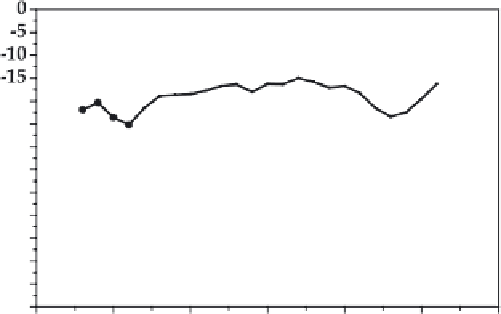Geoscience Reference
In-Depth Information
Fig. 3. Longitudinal variation of surface ADRF (presented as latitudinal average) in
the IGB during the winter (WIN), pre-monsoon (PRM), monsoon (MON), and post-
monsoon (POM) seasons. The vertical bars through each point represent the standard
deviation for 2001-2005.
values and are distinctively lower than the corresponding pre-monsoon
and monsoon values up to 85E longitude. Surface forcing further increases
toward east of this longitude in three seasons except the post-monsoon
season. The spatial variation is less in the winter and post-monsoon seasons,
because these periods are dominated by anthropogenic aerosols, which is
present throughout the basin. On the contrary, in the pre-monsoon and
monsoon seasons, dusts are being transported over the IGB from the
western arid regions influencing the optical properties.
5
The highest surface
forcing in the western part of IGB is due to the strongest dust activities,
which decreases eastward, as the dust loading reduces. Higher standard
deviation in the dust loading seasons indicates higher heterogeneity across
the latitudes, which depends on the transportation path of the dusts.
3.2
. Anthropogenic contribution to aerosol DRF over the IGB
In this section, the variability of anthropogenic contribution to ADRF over
IGB has been discussed with the term “anthropogenic forcing” used for
“anthropogenic ADRF” for the sake of brevity. The relative contribution
of the anthropogenic contribution to ADRF over Kanpur shows strong
seasonal variation (Fig. 4). The mean annual relative contributions to




































